Astronomy guides to 2020 advised that this would be a challenging year for Perseid watchers, when a last quarter Moon will be close to the shower radiant over the peak period. Although the Moon will affect this year’s Perseid meteor shower, that doesn’t mean you should just forget about it.
But waiting for the Perseids means long spells under the stars, so why not take the time to enjoy some other night-sky phenomenon at the same time?
- Find out more about what's going to be visible in the night sky each month with our Online Planetarium.
- Learn more about how to observe and photograph the Perseid meteor shower.
Here's our pick of August 2020's astronomical highlights.
See the planets in the night sky
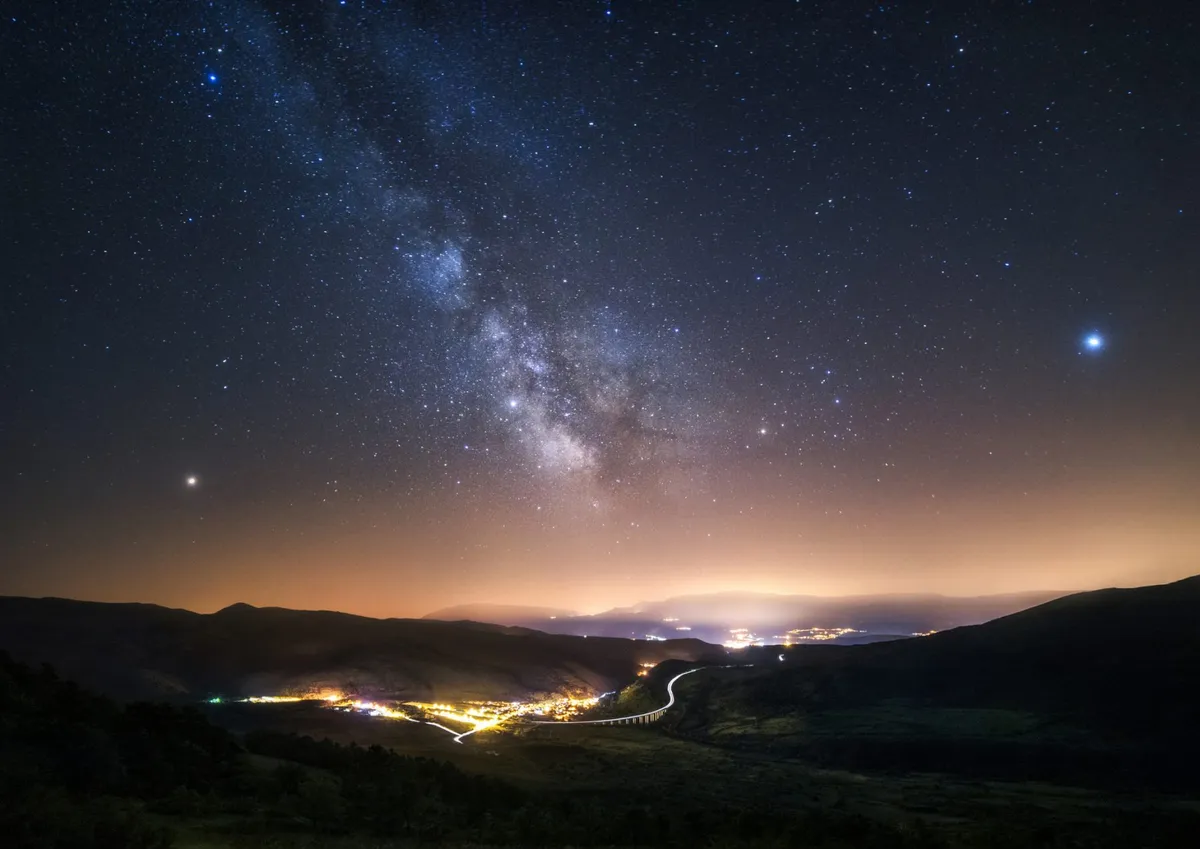
If your observing site has a flat, low horizon from the northeast to the south, you’ll be able to enjoy a a planetary parade.
On the evening of 12 August the show starts with Mars rising in the east around 22:45 BST (21:45 UT). Shining impressively at around mag. –1.3 it will be very obvious to the naked eye, looking like a bright orange spark.
Binoculars will enhance both its brightness and its glorious colour, and a telescope will show you its ochre disc, perhaps even its bright, icy south pole and dark features on its surface. It will dominate the evening sky in a couple of months.
Having found Mars, turn right until you are facing south, where you’ll see what looks like two bright stars in the sky.These stars are actually two more planets.
The brighter of the two will be Jupiter, with fainter Saturn just to its left. Binoculars won’t show you Saturn’s famous rings but you might make out its largest moon, Mercury-sized Titan, as a tiny star close on its right.
Binoculars can also show you Jupiter’s four largest moons and, if you have a telescope with you, Jupiter’s yellow-white disc, crossed by bands of toffee-hued cloud, will be a lovely distraction during lulls in meteor activity.
For more on what will be visible at these gas giants, read our guide on how to observe Jupiter and Saturn.
And for more general tips, find out how to see the planets in the night sky.
The Milky Way

How about a trip along the Milky Way? To begin, look towards the northeast where you’ll see a bright, yellow-white star twinkling away down near the horizon; this is Capella.
A giant star, Capella is almost 43 lightyears away and is the closest first magnitude star to the celestial north pole: at mag. 0.08 it’s the sixth brightest star in the sky.
To Capella’s upper right you’ll see a pattern of stars that might remind you of a wishbone from a cooked chicken or even a pair of garden shears. This is the constellation of Perseus.
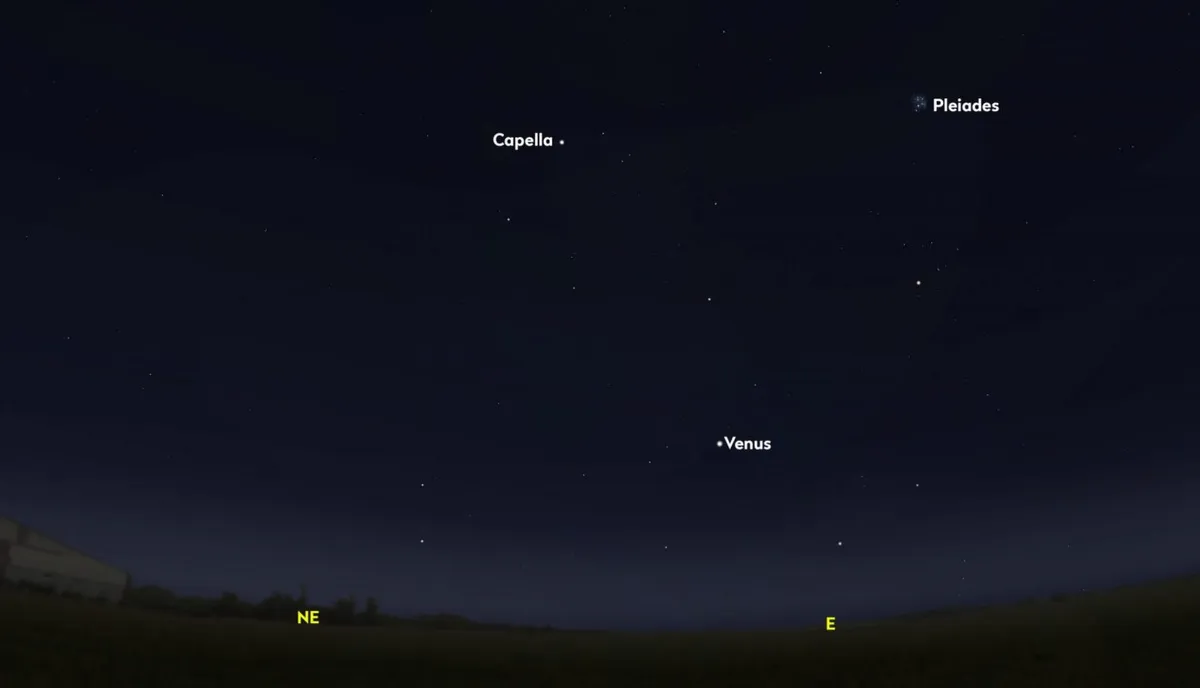
The Perseid meteor shower is named after this constellation because its shooting stars appear to zip away from it during peak activity.
You might recognise heroic Perseus from fantasy films, hacking the serpent-haired head off Medusa and riding his winged horse, Pegasus, across the sky.
Find out more about Capella and other stellar highlights in our guide to the best summer stars.
Double Cluster

Directly above Perseus you’ll see a very distinctive pattern of five stars in the shape of a W. We’ll come back to that.
For now look roughly halfway between that W and Perseus: you’re looking for a misty smudge, more obvious if you look slightly to one side of it.
This is a famous deep-sky object called the Double Cluster, a pair of beautiful, glittering star clusters, each containing thousands of stars. Although they appear to be side by side, the clusters are hundreds of lightyears apart.
Cassiopeia

Back to that W of stars. This is the constellation of Cassiopeia – representing a queen who was tossed into the heavens by the Greek gods for declaring she was more beautiful than any of them – and it can guide you to one of the best-loved deep-sky objects of all.
If you split the W into two Vs the highest one points like an arrowhead to a small smudge.
This is M31, the Andromeda Galaxy, a spiral galaxy around 2.5 million lightyears away that’s roughly twice the size of our Milky Way. It’s the most distant object the naked eye can see.
Under a dark sky a pair of binoculars transforms that smudge into a misty oval, glowing with the combined light of a trillion distant suns.

Cygnus Star Cloud
Next, look almost overhead for what looks like a long, oval-shaped cloud there, almost as if someone has smudged chalk dust on the sky with their fingertip.
This is the Cygnus Star Cloud, a region in the Milky Way so densely packed with stars that it looks like a cloud of smoke to the naked eye, but is resolved into countless stars through binoculars.
To the southeast of the Cygnus Star Cloud is a dark area that looks as if someone has plucked all the stars out of the Milky Way.
This is the Cygnus Dark Rift and it appears dark because clouds of dense interstellar dust are blocking our view of the stars in that direction.
The Summer Triangle
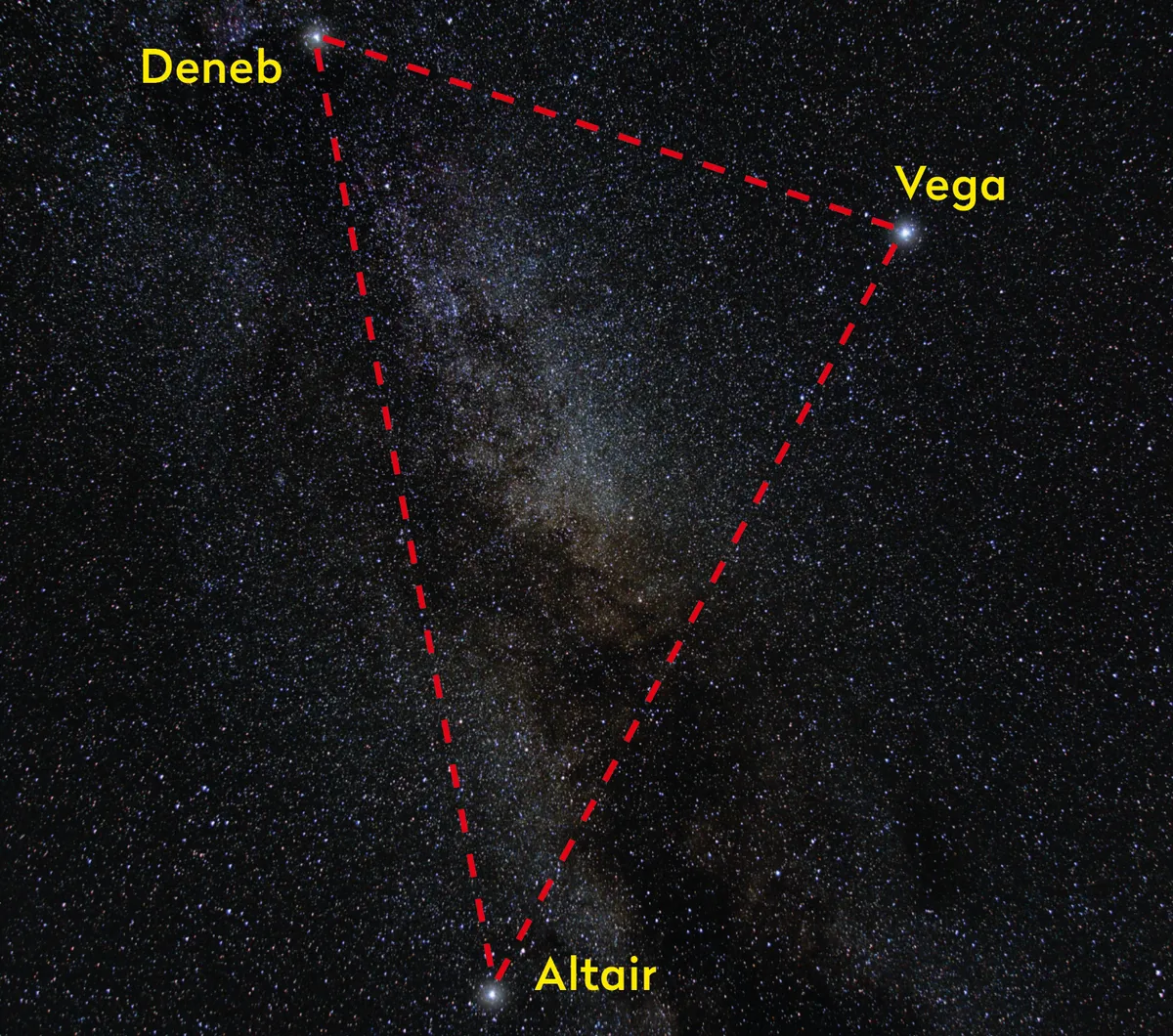
Neatly framing that bright star cloud and the dark rift running down along its side is a triangle of three bright stars.
Deneb, Altair and Vega are known collectively as the Summer Triangle and are three of the brightest stars in the sky, shining at mag. 1.3, mag. 0.93 and mag. 0.0 respectively.
Altair and Vega are both less than 30 lightyears distant, but Deneb is an incredible 2,600 lightyears away.
About 200,000 times more luminous than our own Sun, Deneb is a true giant of a star and was the Pole Star 18,000 years ago.
Due to the precession or wobbling of Earth’s axis it will be an approximate Pole Star again around the year 9800 AD.
Although the Summer Triangle is very distinctive, it’s not equilateral. If you look to Vega’s lower right you’ll see another star, Rasalhague, which is only second magnitude and this can be connected with Vega and Altair to form an equilateral triangle shape.
Below Rasalhague, down towards the horizon the Milky Way grows thicker and more clotted behind a pattern of stars that looks like a teapot or even a genie’s lamp.
Find out more about the Summer Triangle and its celestial neighbours in our guide to the best summer constellations.
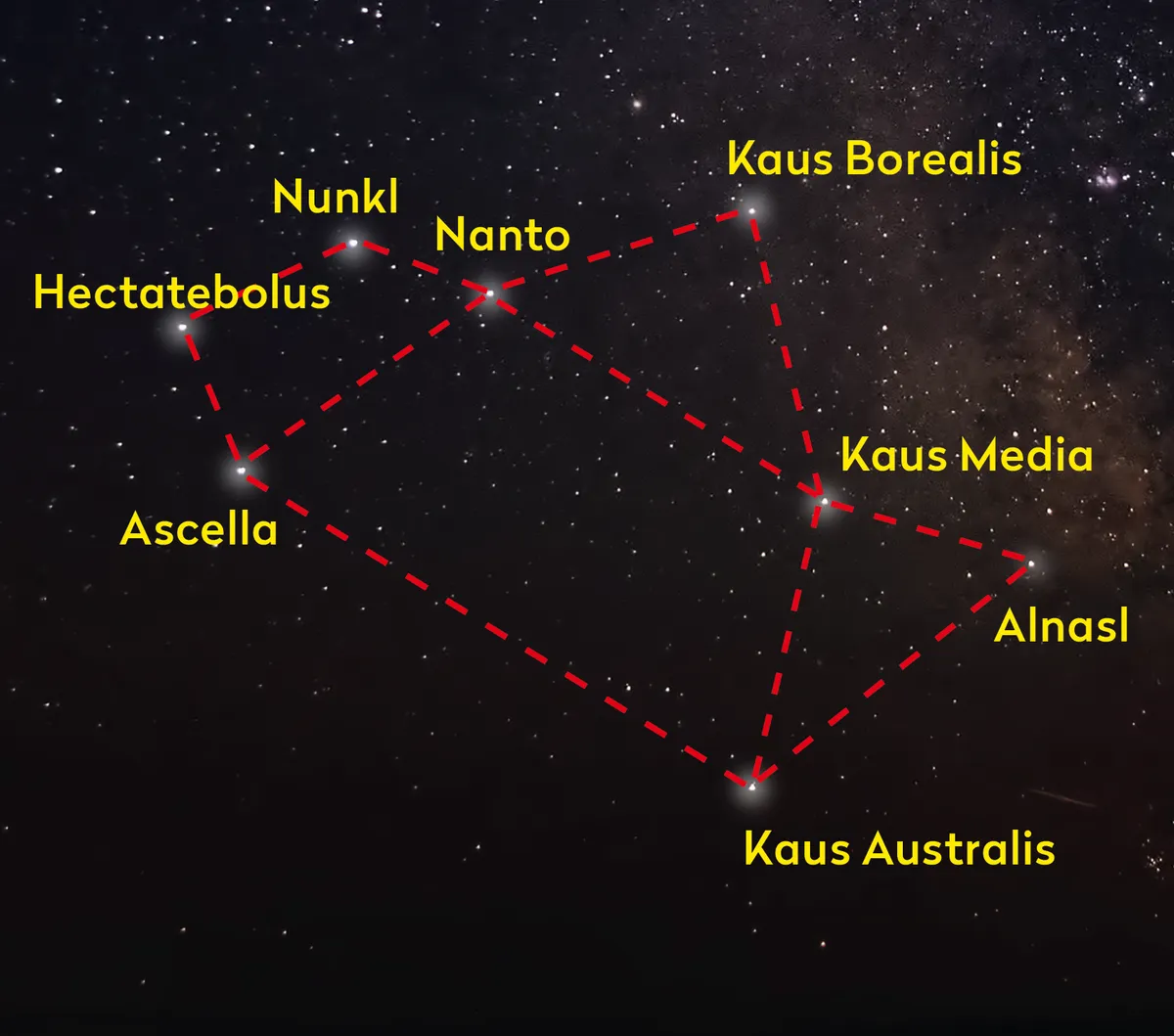
The Teapot asterism is part of the constellation of Sagittarius, and it is crowded with fascinating deep-sky objects.
Unfortunately, this part of the Milky Way never climbs very high in the northern sky, but if you sweep it with binoculars you’ll see a subtle brightening if under dark skies.
It’s a region that contains nebulae, glittering star clusters and simply too many background stars to count.
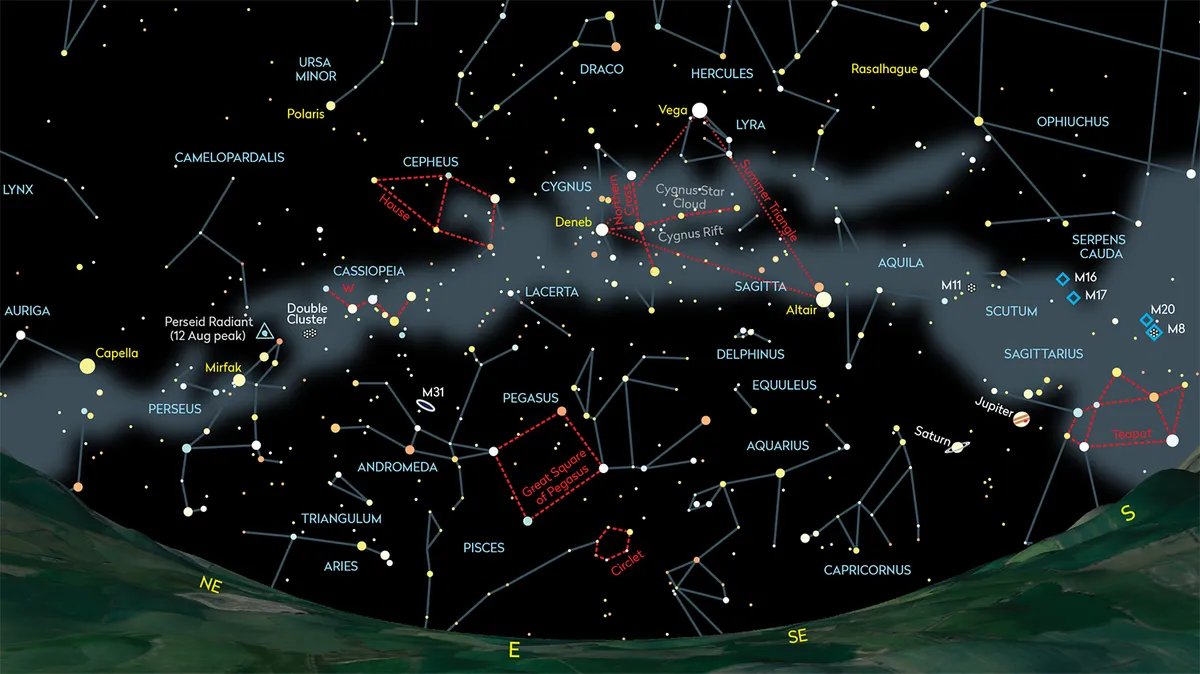
This is the location of famous deep-sky objects such as the Omega Nebula, M17, the Lagoon Nebula, M8, the Trifid Nebula, M20 and the Wild Duck Cluster, M11.Use our chart below to find them.
Our fascinating tour concluded, turn your gaze east and you’ll see the sky brightening in that direction in advance of the Moon rising – at 23.50 BST (22:50 UT) on the night of the 11/12 August and 00:10 BST (23:10 UT) on the night after.
There’s lots to see on the Moon through binoculars, but on these nights the brilliance of its last quarter phase will ruin your dark adaptation.
For now, just be content to stand there in the dark and wait for shooting stars to start skipping across the sky. Even with the Moon there you’ll be in for a treat – and almost certainly a few jaw-dropping moments too.
For more ideas, read our guide to stargazing with binoculars and our beginner's tips on how to observe the Moon.
This article originally appeared in the August 2020 issue of BBC Sky at Night Magazine.
